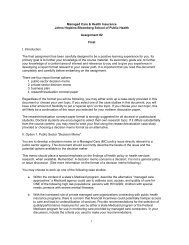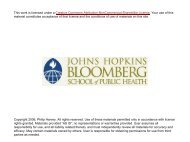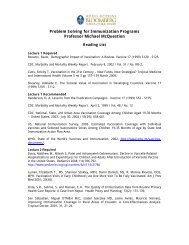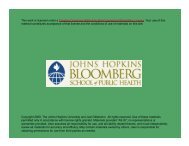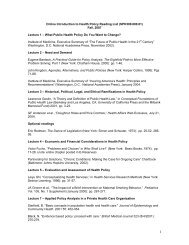Use of Chi-Square Statistics
Use of Chi-Square Statistics
Use of Chi-Square Statistics
You also want an ePaper? Increase the reach of your titles
YUMPU automatically turns print PDFs into web optimized ePapers that Google loves.
This work is licensed under a Creative Commons Attribution-NonCommercial-ShareAlike License. Your use <strong>of</strong> this<br />
material constitutes acceptance <strong>of</strong> that license and the conditions <strong>of</strong> use <strong>of</strong> materials on this site.<br />
Copyright 2008, The Johns Hopkins University and Marie Diener-West. All rights reserved. <strong>Use</strong> <strong>of</strong> these materials<br />
permitted only in accordance with license rights granted. Materials provided “AS IS”; no representations or<br />
warranties provided. <strong>Use</strong>r assumes all responsibility for use, and all liability related thereto, and must independently<br />
review all materials for accuracy and efficacy. May contain materials owned by others. <strong>Use</strong>r is responsible for<br />
obtaining permissions for use from third parties as needed.
<strong>Use</strong> <strong>of</strong> the <strong>Chi</strong>-<strong>Square</strong> Statistic<br />
Marie Diener-West, PhD<br />
Johns Hopkins University
Section A<br />
<strong>Use</strong> <strong>of</strong> the <strong>Chi</strong>-<strong>Square</strong> Statistic in a Test <strong>of</strong> Association<br />
Between a Risk Factor and a Disease
The <strong>Chi</strong>-<strong>Square</strong> ( X 2 ) Statistic<br />
� Categorical data may be displayed in contingency tables<br />
� The chi-square statistic compares the observed count in<br />
each table cell to the count which would be expected under<br />
the assumption <strong>of</strong> no association between the row and<br />
column classifications<br />
� The chi-square statistic may be used to test the hypothesis <strong>of</strong><br />
no association between two or more groups, populations, or<br />
criteria<br />
� Observed counts are compared to expected counts<br />
4
Displaying Data in a Contingency Table<br />
Criterion 2 Criterion 1<br />
1 2 3 C Total<br />
1 n11 n12 n13 n1c r1<br />
2 n21 n22 n23 n2c r2<br />
3 n31<br />
.<br />
.<br />
. . .<br />
. . .<br />
. . .<br />
. . . . . . . . .<br />
r nr1 nrc rr<br />
Total c1 c2 cc n<br />
.<br />
5
<strong>Chi</strong>-<strong>Square</strong> Test Statistic<br />
� The test statistic is:<br />
c 2 k<br />
= ∑<br />
i= 1<br />
� The degrees <strong>of</strong> freedom are:<br />
− (r–1)(c–1)<br />
− r = # <strong>of</strong> rows and c = # <strong>of</strong> columns<br />
� Where:<br />
− Oi = the observed frequency in the ith cell <strong>of</strong> the table<br />
= the expected frequency in the ith cell <strong>of</strong> the table<br />
−<br />
E i<br />
⎡<br />
⎢<br />
⎣<br />
O - E i ) 2 ⎤<br />
E i ⎦<br />
⎥<br />
( i<br />
6
Example: Is Disease Associated With Exposure?<br />
� The relationship between disease and exposure may be<br />
displayed in a contingency table<br />
� We can see that:<br />
37/54 = 68 % <strong>of</strong> diseased individuals were exposed<br />
13/66 = 20 % <strong>of</strong> non-diseased were exposed<br />
� Do these data suggest an association between disease and<br />
exposure?<br />
Disease<br />
Exposure Yes No Total<br />
Yes 37 13 50<br />
No 17 53 70<br />
Total 54 66 120<br />
7
Observed Counts<br />
� The observed numbers or counts in the table are:<br />
Disease<br />
Exposure Yes No Total<br />
Yes 37 13 50<br />
No 17 53 70<br />
Total 54 66 120<br />
8
Test <strong>of</strong> No Association<br />
� Question <strong>of</strong> interest: is disease associated with exposure?<br />
� Calculate what numbers <strong>of</strong> “exposed” and “non-exposed”<br />
individuals would be expected in each disease group if the<br />
probability <strong>of</strong> disease were the same in both groups<br />
� If there was no association between exposure and disease,<br />
then the expected counts should nearly equal the observed<br />
counts, and the value <strong>of</strong> the chi-square statistic would be<br />
small<br />
� In this example, we can calculate:<br />
Overall proportion with exposure = 50/120 = 0.42<br />
Overall proportion without exposure = 70/120 = 0.58 = 1–<br />
0.42<br />
9
Expected Counts<br />
� Under the assumption <strong>of</strong> no association between exposure<br />
and disease, the expected numbers or counts in the table are:<br />
Disease<br />
Exposure Yes No Total<br />
Yes 50/120 x 54 = 22.5 50/120 x 66 = 27.5 50<br />
No 70/120 x 54 = 31.5 70/120 x 66 = 38.5 70<br />
Total 54 66 120<br />
10
<strong>Chi</strong>-<strong>Square</strong>d (X 2 ) Statistic<br />
χ 2 =∑ i<br />
(O i − E i ) 2<br />
E i<br />
2<br />
(37 − 22.5)<br />
=<br />
22.5<br />
2<br />
(17 − 31.5)<br />
+<br />
31.5<br />
+ (13 − 27.5) 2<br />
+ (53 − 38.5) 2<br />
27.5<br />
38.5<br />
11
Test <strong>of</strong> Association<br />
� The test statistic is:<br />
− χ2 = 29.1 with 1 degree <strong>of</strong> freedom<br />
� Assumption: no association between disease and exposure<br />
� A small value <strong>of</strong> the χ2 statistic supports this assumption<br />
(observed counts and expected counts would be similar)<br />
� A large value <strong>of</strong> the χ2 statistic would not support this<br />
assumption (observed counts and expected counts would<br />
differ)<br />
� What is the probability <strong>of</strong> obtaining a statistic <strong>of</strong> this<br />
magnitude or larger when there is no association?<br />
12
Probability Associated with a X 2<br />
Statistic<br />
� If the assumption <strong>of</strong> no association is true, then what is the<br />
probability <strong>of</strong> observing this value <strong>of</strong> the χ 2 statistic?<br />
� Table A.8 <strong>of</strong> the Pagano text provides the probability (area in<br />
upper tail <strong>of</strong> the distribution) associated with values <strong>of</strong> the<br />
chi-square statistic for varying degrees <strong>of</strong> freedom<br />
� Degrees <strong>of</strong> freedom = 1 for a 2x2 table:<br />
13
Conclusion: Test <strong>of</strong> (No) Association<br />
� For the data in this example, χ 2 = 29.1 with 1 degree <strong>of</strong><br />
freedom<br />
� From the chi-squared table, the probability obtaining a<br />
statistic <strong>of</strong> this magnitude or larger when there is no<br />
association is < 0.001<br />
� In other words, the probability <strong>of</strong> obtaining discrepancies<br />
between observed and expected counts <strong>of</strong> this magnitude is<br />
< 0.001 (unlikely to occur by chance alone)<br />
� Conclude that our finding is unlikely to occur if there is no<br />
association between disease and exposure<br />
−<br />
Thus, we conclude that there appears to be an<br />
association<br />
14
Guidelines for Interpreting the X 2<br />
Statistic<br />
� The χ 2 statistic is calculated under the assumption <strong>of</strong> no<br />
association<br />
� Large value <strong>of</strong> χ 2 statistic ⇒ small probability <strong>of</strong> occurring<br />
by chance alone (p < 0.05) ⇒ conclude that association<br />
exists between disease and exposure<br />
� Small value <strong>of</strong> χ 2 statistic ⇒ large probability <strong>of</strong> occurring<br />
by chance alone (p > 0.05) ⇒ conclude that no association<br />
exists between disease and exposure<br />
15
Short-Cut X 2<br />
� Suppose:<br />
� Then we can write:<br />
Formula for 2x2 Table<br />
Disease<br />
Exposure Yes No Total<br />
Yes a b a+b<br />
No c d c+d<br />
Total a+c b+d n<br />
12 χ =<br />
n(ad–bc) 2<br />
(a+ c)(b+ d)(a+b)(c+ d)<br />
16
Short-Cut X 2<br />
� Using this formula for the previous example gives<br />
1 2<br />
2<br />
120[(37)(53) – (13)(17)]<br />
χ =<br />
54(66)(50)(70)<br />
= 29.1<br />
− Same as before!<br />
Formula for the Example<br />
Disease<br />
Exposure Yes No Total<br />
Yes 37 13 50<br />
No 17 53 70<br />
Total 54 66 120<br />
17
Helpful Hints Regarding the <strong>Chi</strong>-<strong>Square</strong> Statistic<br />
� The calculations use expected and observed counts or<br />
frequencies, not proportions<br />
� The χ 2 short-cut formula applies only to 2x2 tables<br />
� Probabilities are available from tables and computing<br />
packages<br />
18
Review<br />
� The χ 2 statistic provides a statistical test for ascertaining<br />
whether an association exists between disease and exposure<br />
� A large value <strong>of</strong> the χ 2 statistic indicates that the observed<br />
data are unlikely under an assumption <strong>of</strong> no association<br />
between disease and exposure ⇒ small probability (pvalue)<br />
⇒ association<br />
� A small value <strong>of</strong> the χ 2 statistic indicates that the observed<br />
data are likely under an assumption <strong>of</strong> no association<br />
between disease and exposure ⇒ large probability (pvalue)<br />
⇒ no association<br />
19
Section B<br />
Applications <strong>of</strong> the <strong>Chi</strong>-<strong>Square</strong> Statistic in Epidemiology
Applications <strong>of</strong> the X 2<br />
� Cohort study (2 samples)<br />
� Case-control study (2 samples)<br />
Statistic in Epidemiology<br />
� Matched case-control study (paired cases and controls)<br />
21
Cohort Study 2x2 Table<br />
Disease<br />
Factor Present (D) Absent (D) Total<br />
Pres ent (F) a b a+b<br />
Abs ent (F) c d c+d<br />
Total a+c b+d N<br />
22
Cohort Study: Measure <strong>of</strong> Association<br />
� Assumptions:<br />
The two samples are independent<br />
� Let a+b = number <strong>of</strong> people exposed to the risk<br />
factor<br />
� Let c+d = number <strong>of</strong> people not exposed to the risk<br />
factor<br />
� Assess whether there is association between exposure and<br />
disease by calculating the relative risk (RR)<br />
23
Cohort Study: Relative Risk<br />
� We can define the relative risk <strong>of</strong> disease:<br />
p1= P(disease factorpresent)=P(DF)<br />
p2 = P(disease factor absent)=P(D F )<br />
RR = p1<br />
p2<br />
= P(DF)<br />
P(D F )<br />
is called the relative risk<br />
24
Cohort Study: Test <strong>of</strong> Association<br />
� For these samples, we can estimate the relative risk as:<br />
a<br />
RR = a+b<br />
c<br />
c+d<br />
� We can test the hypothesis that RR=1 by calculating the chisquare<br />
test statistic<br />
χ 2<br />
1 =<br />
n(ad–bc) 2<br />
(a+ c)(b+ d)(a+b)(c+ d)<br />
25
Example: Test <strong>of</strong> Association in a Cohort Study<br />
� RR = 1.61<br />
� <strong>Chi</strong>-square statistic = χ 2 1<br />
Develop CHD<br />
Smoke Yes No Total<br />
Yes 84 2916 3000<br />
No 87 4913 5000<br />
Total 171 7829 8000<br />
= 10.1 =<br />
8000(84(4913)−2916(87)) 2<br />
(84+87)(2916+ 4913)(84+2916)(87+ 4913)<br />
26
Example: Test <strong>of</strong> Association in a Cohort Study<br />
� Using Table A.8 in the Pagano text, the probability is less<br />
than 0.010 (between 0.001 and 0.010)<br />
� This supports an association between exposure and<br />
disease<br />
j<br />
27
Case-Control Study 2x2 Table<br />
Disease<br />
Factor Present (case) Absent (control) Total<br />
Pres ent a b a+b<br />
Abs ent c d c+d<br />
Total a+c b+d N<br />
28
Case-Control Study: Measure <strong>of</strong> Association<br />
� Assumptions<br />
− The samples are independent<br />
� Cases = diseased individuals = a+c<br />
� Controls = non-diseased individuals = b+d<br />
� We are interested in whether:<br />
P( F D) = P( F D )<br />
� We cannot estimate P(D), the prevalence <strong>of</strong> the disease and,<br />
hence, cannot estimate the RR<br />
� Assess whether there is association between exposure and<br />
disease by calculating the odds ratio (OR)<br />
29
Case-Control Study: Odds for Diseased Group<br />
� The odds <strong>of</strong> exposure for the diseased group is:<br />
p 1<br />
1−p 1<br />
=<br />
a<br />
a+ c<br />
c<br />
a+ c<br />
= a<br />
c<br />
Disease<br />
Factor Present (case) Absent (control) Total<br />
Present a b a+b<br />
Absent c d c+d<br />
Total a+c b+d N<br />
30
Case-Control Study: Odds for Non-Diseased Group<br />
� The odds <strong>of</strong> exposure for the non-diseased group is:<br />
p 2<br />
1−p 2<br />
=<br />
b<br />
b+d<br />
d<br />
b+d<br />
= b<br />
d<br />
Disease<br />
Factor Present (case) Absent (control) Total<br />
Present a b a+b<br />
Absent c d c+d<br />
Total a+c b+d N<br />
31
Case-Control Study: Odds Ratio<br />
� The odds ratio is:<br />
p 1<br />
1−p 1<br />
p 2<br />
1−p 2<br />
� And is estimated by OR =<br />
a<br />
c<br />
b<br />
d<br />
= ad<br />
bc<br />
32
Case-Control Study: Test <strong>of</strong> Association<br />
� We can test whether OR=1 by calculating the chi-square<br />
statistic:<br />
χ<br />
2<br />
1<br />
2<br />
n(ad — bc)<br />
=<br />
(a + c)(b + d)(a + b)(c + d)<br />
33
Example: Test <strong>of</strong> Association in a Case-Control Study<br />
Past<br />
Smoking<br />
Disease<br />
CHD Cases Controls Total<br />
Yes 112 176 288<br />
No 88 224 312<br />
Total 200 400 600<br />
� OR = 1.62<br />
� <strong>Chi</strong>-square statistic = χ 2 1<br />
= 7.69 =<br />
2<br />
600(112(224)<br />
— 176(88))<br />
(112 +<br />
88)(176 + 224)(112 + 176)(88 + 224)<br />
34
Example: Test <strong>of</strong> Association in a Case-Control Study<br />
� Using Table A.8 in the Pagano text, the probability is between<br />
0.001 and 0.01<br />
� This supports association between exposure and disease<br />
35
Matched Case-Control Study Table<br />
Cases<br />
Controls<br />
Exposed Not Exposed<br />
Exposed aa bb<br />
Not exposed cc dd<br />
36
Matched Study: Measure <strong>of</strong> Association<br />
� Assumptions<br />
− Case-control pairs are matched on characteristics such as<br />
age, race, sex<br />
− Samples are not independent<br />
� The discordant pairs are case-control pairs with different<br />
exposure histories<br />
− The matched odds ratio is estimated by bb/cc<br />
� Pairs in which cases exposed but controls not = bb<br />
� Pairs in which controls exposed but cases not = cc<br />
−<br />
Assess whether there is association between exposure<br />
and disease by calculating the matched odds ratio (OR)<br />
37
Matched Case-Control Study: Test <strong>of</strong> Association<br />
� We can test whether OR = 1 by calculating McNemar’s<br />
statistic<br />
� McNemar’s test statistic:<br />
χ<br />
2<br />
1<br />
=<br />
( bb − cc<br />
−1)<br />
(bb + cc)<br />
2<br />
38
Example: Test <strong>of</strong> Association in a Matched Study<br />
Cases<br />
� OR = bb/cc = 4<br />
� McNemar’s test statistic =χ 2 1<br />
( 4 −1<br />
−1)<br />
2<br />
χ1<br />
=<br />
(4 + 1)<br />
= 0.80<br />
Controls<br />
Exposed Not Exposed<br />
Exposed 2 4<br />
Not exposed 1 3<br />
2<br />
39
Example: Test <strong>of</strong> Association in a Matched Study<br />
� Using Table A.8 in the Pagano text, the probability is greater<br />
than 0.100<br />
� This supports no association between exposure and disease<br />
40
Review: <strong>Use</strong>s <strong>of</strong> the <strong>Chi</strong>-<strong>Square</strong>d Statistic<br />
� The chi-squared statistic provides a test <strong>of</strong> the association<br />
between two or more groups, populations, or criteria<br />
� The chi-square test can be used to test the strength <strong>of</strong> the<br />
association between exposure and disease in a cohort study,<br />
an unmatched case-control study, or a cross-sectional study<br />
� McNemar’s test can be used to test the strength <strong>of</strong> the<br />
association between exposure and disease in a matched casecontrol<br />
study<br />
41
Review: Association between Exposure and Disease<br />
� The χ 2 statistic is calculated under the assumption <strong>of</strong> no<br />
association<br />
� A large value <strong>of</strong> the chi-square or McNemar’s test statistic ⇒<br />
small probability ⇒ supports an association<br />
� A small value <strong>of</strong> the chi-square or McNemar’s test statistic ⇒<br />
large probability ⇒ does not support an association<br />
between exposure and disease<br />
42





